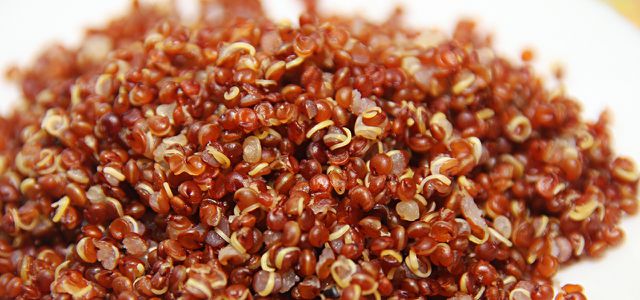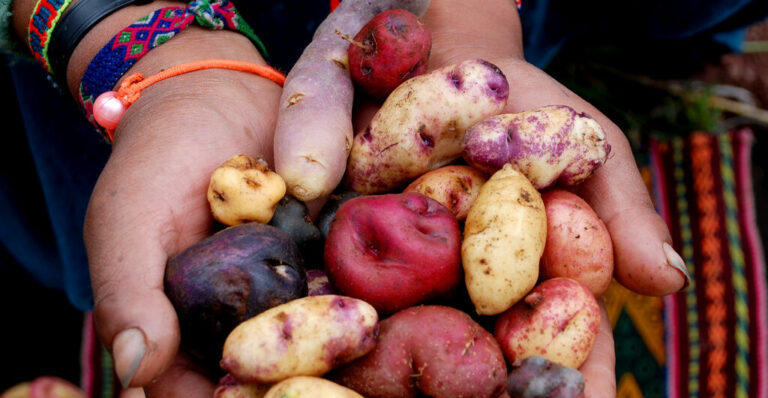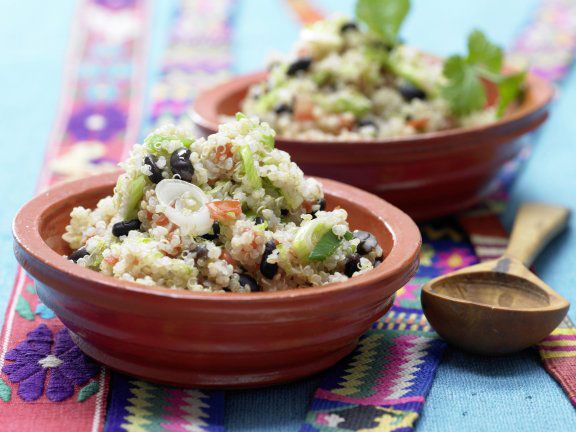Suddenly everyone is eating quinoa, organic stores sell it, veggie burgers are based on it. Utopia took a closer look at the hype grain and discovered a lot of positive things about Andean millet – but also a downside.
In the Andes region of South America, quinoa has been considered a nutrient- and energy-rich staple food for about 6000 years. The Spanish conquerors regarded the “Inca wheat” as cheap poor people’s food, and in some cases they banned it. Unlike corn, the plant was therefore practically unknown in Europe until a few decades ago.
It wasn’t until the 1990s that quinoa was rediscovered as a food here: the nutrient-rich grains were particularly popular in health food stores and alternative cuisine. In 2013, the plant was even voted “Plant of the Year”, and today it is considered a gluten-free superfood. But the hype surrounding quinoa also causes problems.
Quinoa: what is it anyway?

Quinoa is an ancient annual crop and, like amaranth, belongs to the foxtail family. You can eat the young sprouts and leaves of quinoa, but you mainly use the seeds by simply cooking them like rice (see 8. Recipes).
White quinoa is the most common, and usually a little cheaper. It is the lowest in fat and has a nutty taste. The cooking time is 10 to 15 minutes.
Black quinoa doesn’t really taste any different, but it is a bit harder, and takes 15 to 20 minutes to cook.
Red quinoa takes a little longer to cook than black quinoa. Because it keeps its shape and looks pretty, it’s a popular choice for salads.
Puffed quinoa is, so to speak, the popcorn of the Incas and, like quinoa flakes, is mainly used as an ingredient in muesli.
Quinoa blends with two or three colors are also common. Because the Inca grain, unlike rye or wheat, is not a sweet grass, the seeds are gluten-free. The plant is therefore also referred to as a “pseudo grain”, since in practice there is hardly any difference to grain.
The quinoa plant is undemanding: it is sown on loose soil that is as weed-free as possible; Fertilizing and watering is practically not necessary and can even reduce the yield. However, cultivation is now leading to social and economic problems in the growing countries – see point 9: Sustainability.
Nutrition facts: is quinoa healthy?
The Incas revered quinoa as a miracle plant – and rightly so: its nutritional values make the pseudo-cereal extremely healthy. Quinoa is an excellent source of essential amino acids such as lysine, tryptophan or cystine and provides polyunsaturated fatty acids. In addition, quinoa has a high content of minerals – including magnesium (approx. 300 mg), iron (approx. 8 mg), potassium (approx. 800 mg) and calcium (approx. 120 mg), but also manganese.
This made quinoa interesting as a healthy source of protein for vegans, but also caused a certain amount of hype for conventional healthy diets. However, just because you eat quinoa doesn’t make you “healthier”. And with a balanced diet with regional fruit, vegetables and grains, you can do without the Inca food in this country, the procurement of which is associated with sustainability problems.
Quinoa and carbohydrates: is the trend suitable for the low-carb diet?
Eating quinoa as a grain substitute as part of a low-carb diet does not make sense. The pseudo-grain is very high in energy (depending on the variety, around 400 kilocalories per 100 grams). It also supplies this energy via the fats it contains (mainly unsaturated), but mainly from carbohydrates.
After all, these are rather complex carbohydrates that have to be broken down before they can be used by the body. In contrast to normal cereals, quinoa keeps you full for longer and avoids food cravings. But if you want to avoid carbohydrates, you should look for alternatives.
Ingredients: Is quinoa unhealthy?
As with all foods, there are components in quinoa that are not particularly digestible. To protect against pests, the shell of the seeds contains the bitter saponins, which can damage the intestinal mucosa and blood cells. In the unpeeled state, the seeds are therefore not suitable for consumption. Even when peeled, the grains should always be rinsed well or boiled to remove the remaining saponins as much as possible.
Particular caution is required for people with diseases of the intestine or for small children up to about two years of age: In both cases, the intestinal mucosa is not robust enough, the saponins can get into the blood and attack the red blood cells in particular. Seeds available in Germany are already hulled. You should wash them again though.
No gluten – ideal grain substitute

Since the plant is not a sweet grass, quinoa does not contain any gluten. This makes the seeds an interesting alternative as a side dish, especially for people with celiac disease or a milder form of gluten intolerance.
When baking, however, the “gold of the Incas” is not an alternative: the gluten protein ensures that dough for bread or cakes becomes fluffy and airy during baking. Since quinoa lacks gluten, baking with quinoa flour alone is difficult; however, you can substitute some of the regular flour with it to lower the gluten content of the pastry. There are also gluten-free pasta varieties with the pseudo-grain quinoa.
But here, too, the following applies: Eating the gluten-free pseudo-grain “as a preventive measure” without a specific need, in the hope that it is somehow healthier, is rather nonsensical in view of the sustainability problems. Gluten-free cereal substitutes only make sense if you have actually received a medical diagnosis for celiac disease, i.e. real gluten intolerance. Gluten-free pasta often contains more cornmeal and rice flour than quinoa.
Is quinoa suitable for a diet?
Quinoa is healthy, contains many nutrients and is gluten-free. However, the pseudo-grain also contains a lot of energy, which at first glance makes it unsuitable for a diet. At second glance, it is noticeable that the ratio of energy to nutritional value is significantly higher here than with conventional grain.
In this respect, the Inca wheat can be easily integrated into a balanced nutrition plan, since more nutrients can be absorbed with a smaller amount and the total calorie intake can be reduced. Instead of going on a diet, it makes more sense to fundamentally change your diet – and that can also be done with regional products.
Buying quinoa: what is important?
Because quinoa is part of the superfood hype, you can now buy it in many places – unfortunately only rarely as a fair trade product. Even discounters have the seeds in their program again and again. The prices for the pseudo-grain vary between around five and twelve euros per kilogram for peeled, natural quinoa seeds. Puffed grains or flakes are slightly more expensive because they have been further processed.
The easiest way to obtain the products is through health food stores, natural food and organic shops, but also supermarkets, drugstores with a food department and organic supermarkets.
When buying quinoa, in addition to processing, it is particularly important to look for organic seals or symbols and the Fairtrade seal on the packaging. This is the only way for farmers in the Andes in Peru and Bolivia to benefit from their work with the cultivation of the grain substitute.
Quinoa recipes and tips
Although the pseudocereal can be enjoyed in many ways, the most popular variant is still as a side dish, cooked like rice.
Put the quinoa grains in a saucepan with twice the amount of cold water and bring to the boil.
Then the grains should simmer for about 10 minutes on a low flame and then swell for another 10 minutes with the stove off.
Refined with a little salt and butter or olive oil before serving, the nutty taste of quinoa comes into its own.
Alternatively, quinoa can be enjoyed fresh and summery as a tasty quinoa salad with avocado, mango and onions, perfect for a bit of the exotic in cloudy German summers. For lovers of fiery, South American delicacies, there is a chili con quinoa, where the meat is replaced with the seeds. The versatile grains set virtually no limits to the imagination when preparing them.
Sustainability: Downsides of the quinoa boom

When it comes to sustainability, there is a lot to be said against Inca wheat. Because quinoa is only rarely cultivated in Europe and Germany, the pseudo-grain grows almost exclusively in its region of origin in the Andes.
About 95 percent of the total world production is grown in Peru, Bolivia and Ecuador. The transport routes from the fields in South America to Europe are extremely long (similar to rice), which means that, given the current level of transport, there is a high level of climate pollution from fossil fuels.









